Facts About Your Car’s Cooling System
Understanding the components of your car’s water-cooling system can save you from serious damages and help you quickly pinpoint the cause of an overheating problem or leak. A basic cooling system is comprised of coolant, a radiator, radiator cap, heater core, durable rubber hoses, head gasket, o-ring seals, hose clamps, a water pump, a thermostat, and a water jacket. Let’s discuss the role of the components in greater detail below and the signs that they need replacements from PartMax.
Coolant
Coolant is a mixture of antifreeze and water that is usually 50/50. There are two types of fluorescent-colored antifreeze liquids commonly used: ethylene glycol and propylene glycol. Not only does the proper mixture of antifreeze and water help prevent freezing at cold temperatures, but it also inhibits corrosion of cooling system parts and raises the boiling point of the coolant to prevent it from vaporizing into steam. Coolant is rarely changed until it turns brown or is found to be acidic. A hydrometer is used to check ethylene glycol while pH strips may indicate acidity below 7.0 in propylene.
Radiator
A car radiator in Miami is typically made of aluminum in late-model vehicles and mounted in front of the engine for maximum airflow through the grille. The air passes over the finely finned tubing of the heat exchanger and in-turn cools the hot coolant passing through it. When a vehicle is at idle, the fan may switch on to mimic the effect of driving at speed. A car radiator in Miami is more likely to leak at the seams or develop pinholes than to become clogged with debris. In either case, a visual inspection may suffice to determine damage.
Radiator Cap
The radiator cap is pressure-rated to release coolant or steam if the coolant overheats. This is more practical than blowing out a hose or the heater core. Many leaks have been attributed to a bad pressure relief valve in a radiator cap. It may be difficult to see small leaks that wick away from the origin. A quick test would be to tie a white cloth around the neck of the cap to determine if the leak is flowing from that junction.
Water Pump & Thermostat
The water pump and thermostat work together to circulate water and open the port for cooling once the engine reaches operating temperature. The water pump uses an impeller driven by a pulley to circulate the coolant in the hollow passages of the engine called the water-jacket. The pump is usually located in the lower part of the engine block and contains the thermostat in the same internal housing. The thermostat is a device that acts as a check valve and responds to temperature. Many times an engine can overheat if the thermostat housing is leaking or the thermostat seizes shut and does not open to allow the coolant to flow to the car radiator in vehicles. The water pump can also seize from corrosion or excessive wear and is usually changed with the thermostat when the timing belt is replaced.
Everything Else The O-rings, hoses, head gasket, and hose clamps available from PartMax connect these core components. The heater core is a type of heat exchanger that is similar to the radiator but, instead, works with your interior fan to radiate the heat through interior vents. Heater cores, clamps, hoses, head gaskets, and O-ring seals that join coolant fixtures to the engine can all leak and lead to engine overheating. When your coolant system starts to leak or overheat, paying prompt attention can save your engine head from warping and other costly repairs.
Remember that if you need a car radiator in Miami or other cooling parts from condensers to fans, you can find them and other aftermarket parts at PartsMax.


